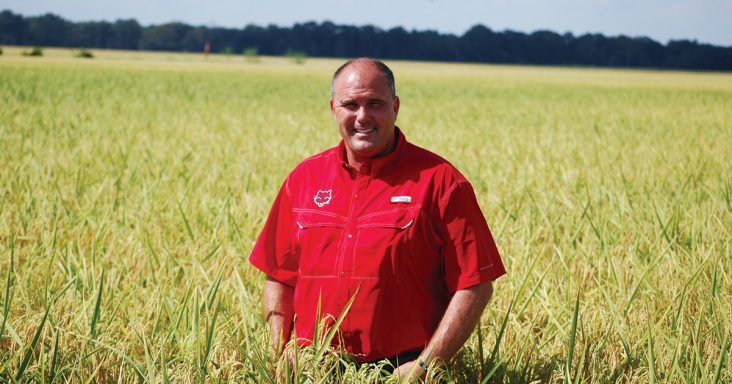Voluntary farming practices aim to aid farmers, protect environment
by August 17, 2021 5:38 pm 887 views

Arkansas farmer Jim Whitaker of McGhee.
Creating enough food to feed the world this century while being mindful of environmental change will provide unique challenges for farmers. President Joe Biden’s election also ensures a policy shift at the federal level when it comes to promoting and mandating practices that will conserve and protect water resources in the agricultural sector.
The Arkansas Rice Federation (Arkansas Rice), the state’s largest rice industry trade association, has joined the Rural Investment to Protect Our Environment (RIPE) Ag Steering Committee. It’s a farmer-led nonprofit advancing a national climate policy that invests in voluntary agricultural stewardship practices that provide a reasonable return to farmers and the public.
Some practices promoted include alternate wetting and drying (AWD) in rice fields and cover crop practices.
“We believe farmers have a role to play in tackling climate change, but they shouldn’t sacrifice their own prosperity in the process,” said Aliza Wasserman-Drewes, RIPE executive director. “The RIPE100 plan is different from other market options as it pays $100 per acre for stewardship. In addition to carbon sequestration, the program compensates farmers for improving soil health, water quality, biodiversity and more. Arkansas Rice has been engaged in RIPE’s efforts to develop climate policy options that recognize and reward practices already being implemented by producers.”
AWD is also known as intermittent flooding. AWD is the practice of flood initiation and recession. It was first developed at the International Rice Research Institute (IRRI), according to the University of Arkansas Division of Agriculture. As a rice flood management practice, AWD is used to maximize rainfall capture and reduce irrigation pumping while maintaining grain quality and yield. AWD consists of flooding a field to a reasonable depth and allowing the flood to naturally subside to the soil surface via infiltration and evapotranspiration, the UA reported.
This subsidence can be a mud (or drier) consistency at the soil surface before reflooding depending on field specifics including soil texture and irrigation capacity. The timing, frequency, and extent of the wetting and drying cycles depend on rice growth stage, prevailing weather and field conditions, and grower comfort level with the practice. After holding the initial flood for three weeks, it is common to refrain from applying a flood for five or more days between wet-dry cycles when using AWD, according to UA researchers.
There are risks associated with AWD practices, researchers found. Stress causes lower yields and quality. Water stress will occur if the field is allowed to dry too much and/or if the flood is not re-established in a timely manner, as can occur with undersized wells, irrigation system failure, and/or human error. Late-planted rice (late May and June) is susceptible to disease and should not be managed using AWD flooding.
Rice is still a dominant crop in Arkansas, but the overall number of acres declined this year due to prices. Decade high prices for corn and soybeans prompted the shift. Arkansas rice growers planted about 18% fewer acres this year, falling from about 1.46 million acres in 2020 to about 1.24 million acres. Rice acreage fell nationwide by about 10%, from 3 million acres planted in 2020 to about 2.7 million acres in 2021. This trend includes long, short and medium grain rice. Jarrod Hardke, extension rice agronomist for the Division of Agriculture, said about 3% of rice (or 37,200 acres this year) are irrigated with intermittent flooding.
Arkansas farmer Jim Whitaker of McGhee has been using AWD concepts on his farm for nearly a decade. Whitaker told Talk Business & Politics he heard about AWD at a conference and began to research the benefits of using less water and nitrogen on his rice crops. The practice can reduce input costs and conserve water, he added.
Instead of flooding rice fields continuously, water is intermittently applied when needed. Sensors let farmers know when the water level on the fields is too low. Weed control can be a challenge because fully flooded fields tend to kill weeds. Another challenge is determining how much fertilizer to use, Whitaker added.
It took several years to strike the right balance in those fields, but the impacts have been dramatic. Whitaker estimates his farm operations use about 50% less water and 20% less nitrogen.
“We’re not constantly putting water on a field. We can now capture rain events. The biggest benefit is that we can capture rainfall,” he said. “It’s a very analytical process.”
Another environmentally friendly practice employed by Whitaker is the use of cover crops. Cover crop practice has been used for years. A cover crop is a not-for-cash crop that is planted on a field off-season. The “cover crop” stops soil erosion, keeps and replenishes nutrients in the soil. Cover crops allow for much less tillage of the soil. That saves on fuel costs and reduces carbon emissions. It improves insect and weed control in fields, too, Whitaker added. It improves soil biodiversity and water collections.
Besides rice, Whitaker farms soybeans, cotton and corn. The longtime family farmer uses cover crops such as cereal, rye, and black oats on these fields. The crop covers the field in the off-season and then leading up to the planting season the crop is typically tilled or burned. It releases nutrients back into the soil.
Learning how to utilize cover crops in different fields can be a challenge, Whitaker admitted. He said it took them several years to “get it right.” The federal government needs to assist farmers to encourage them to do it, he said.
“It’s a huge learning curve. … It’s a process,” he said. “It’s the right thing to do.”
